PARISH OF ST. PETER'S, SHANKILL
by Frank McCorry
The Parish of Shankill and the Parish of Seagoe
occupy a considerable portion of the southern shore of Lough Neagh.
Until the formation of the modern Parish of Moyraverty, Shankill and
Seagoe were the only parishes of the Dromore Diocese located in County
Armagh. Until c.1750, Seagoe was considered the more important of the
two under Catholic aegis.
The origin of the Parish of Shankill is by no means
as clear-cut in historical documents as might be assumed. That there was
a pre-Reformation church in Shankill townland not far distant from the
heart of Lurgan town, is affirmed by its inclusion in the Plantation
maps of 1609. Therefore, the subsequent foundation of Lurgan town by the
incoming colonists, the Brownlows, undoubtedly gave Shankill its
prominence. Yet, one hundred years later, at the Registration of
Catholic Priests at Lurgan courthouse, on July 10th. 1704, no priest
came forward to represent Shankill. The Reverend John Byrne, parish
priest of Seagoe, represented both parishes.
There were other church-sites close-at-hand which may
have been as worthy of parish status as Shankill. In 1440, the income
from Seagoe Parish was so small that it could not support a parish
priest, so it was united to neighbouring Enachloisgy or Annaloiste,
lying on the very shore of the great lough. Fifty years later, in 1492,
further consolidation of northern parishes was approved and Kylilan,
Tayagoba and Acadle were united. These three names are generally
perceived as Shankill, Seagoe and Aghalee respectively. Additional
licence is assumed by taking Kylmilan, Kilwilke and Shankill as
referring to the same entity, an assumption which few really believe.
The late Dean Bernard Mooney was in no doubt that the Church of
Annaloiste was Kilwilke, derived from Kylmilcon and associated with an
early saint named Micho or Milchu.
The parishes of Shankill and Seagoe remained united
from 1492 until 1788 when the union was dissolved. As the town of Lurgan
increased in size, population and relative prosperity, the Parish of
Shankill grew in prominence. And as if to herald this new importance,
nine and a half important townlands were transferred from Seagoe to
Shankill, in 1819, by the Most Reverend Dr. Edmund Derry, Bishop of
Dromore, and a native of Ballynamoney, near Lurgan. These were, Drumgask,
Moyraverty, Annaloiste, Boconnell, Drumnakelly, Kinnego, Knockramer,
Silverwood, Turmoyra, and half of the major townland of Ballinamoney. It
is a fact that right up until the middle of the 20th. century, many
families from these transferred townlands retained some allegiance and
much affection for their former parish.
At the registration of County Armagh priests in
Lurgan,on July 10th. 1704, the Reverend John Byrne, Parish Priest of
Seagoe, represented Shankill Parish also. This infers that there was no
priest ministering in Shankill, but other sources indicate that the
Reverend Richard McGinn was baptising children in the district. This
evidence is written into the local Church of Ireland baptism register.
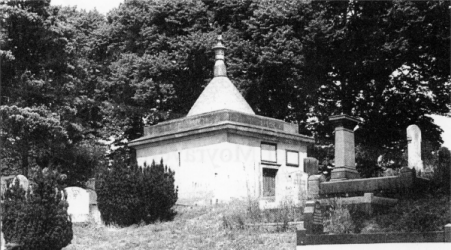
The Brownlow burial
vault occupies the site of the pre-Reformation church of
Shankill. The church stood on elevated ground within a
medium-sized ringfort bound on the north side by a tiny river.
The Brownlows buried within the nave of the church since their
arrival in Lurgan in 1610. No trace now remains of the old
church nor of the graves of those who established the site
probably in the 13th.-14th. century period.

For the 18th. century period, the location of Mass
sites in Shankill Parish cannot be detailed with any certainty. A
Mass-garden is shown in Tannaghmore North on John Rocque's Map of County
Armagh, 1760, but this is unlikely to have been the sole location of
Catholic worship in the overall Shankill Parish. The old church site in
Shankill had been taken over by the Anglican in-corners soon after the
Plantation although local Catholics continued to use the adjoining
graveyard without hindrance. Around 1800, the Brownlow landlord family
made a gift to the Catholics of Lurgan of a mill-warehouse which stood
on a rise a little distant from the Dougher stream, now piped, and which
flows at the bottom of the greatly treasured Dougher graveyard. At this
time, the Catholic population of Shankill Parish was almost entirely
rural, concentrated in the townlands a little distant from town.
With the population of Ireland as a whole, and County
Armagh in particular, undergoing rapid expansion, the converted
church-warehouse in Dougher became too small to cater for Catholic
parishioners. And then, most likely as an acknowledgement that the
long-awaited Catholic Emancipation Act of 1829 had come to pass, the
Brownlows donated the Dougher field which surrounded the primitive
chapel to the Catholic people as a graveyard, and an elevated site in
North Street, Lurgan, for the erection of a proper church. In 183031,
the Reverend William O'Brien, from the Broadwater area of Aghalee, began
the building of the first St. Peter's Church on the site.
The church was a relatively long building which ran
parallel to the narrow street on an approximate east-west axis, the
traditional orientation of a Christian church. The chapel at Lisnagade,
near Loughbrickland, is quite similar to the original St. Peter's Church
in size, shape, distance from the road, and directional orientation.
Interestingly, Alex Richmond's Map of Lurgan, 1832, includes both the
Dougher Chapel and the new St. Peter's Church.
Since then, St. Peter's has been enlarged and
remodelled in various phases and is now one of Ireland's finest parish
churches. Its progression towards the magnificent edifice Shankill
parishioners now have for Mass, devotion and reflection is the legacy of
many fine priests and many thousands of faithful parishioners. If the
tall tapering spire is an expression of exhilaration and jubilation in
freedom and ease of worship, the beautiful sanctuary, enhanced by
coloured and golden mosaic, is the focus of constant prayer in a
location central for the great majority of parishioners.
A glance at some social and economic material
relating to Lurgan and Shankill Parish from the mid-l9th.century onwards
demonstrates the characteristics which made the parish different from
any other while still displaying demographic trends similar to these of
many other districts. The whole economic emphasis in the area during the
entire 18th. century had been on fine linen manufacture. While the
industry allowed money to percolate through all sectors of the
population, it also attracted disadvantaged people from all the
neighbouring parishes which meant that there was always a considerable
number of poorer families within the town and surrounding districts.
With Lurgan the centre of a very populous administrative Union, families
came in big numbers seeking solace and relief from hardship. This was
the situation when the Great Famine struck the land in October 1846. Ten
years later, following the part-mechanisation of the linen trade, major
growth of population was recorded within all parts of Shankill Parish.
Streets of new houses were erected alongside the new
factories where restriction on the level of wages paid meant that women
in the workforce greatly outnumbered men. And then, the large
year-on-year population increases of 1851-71 which had accompanied the
growth of the local linen industry halted as investment slowed and
house-building declined. Linen manufacture continued to generate an
abundance of female employment, and the gender balance within the parish
became greatly distorted.
In 1891, following an influx of families from
neighbouring rural districts, there were almost 700 more Catholic
females than males in Shankill parish, many of whom were of marriageable
age. In 1901, in Lurgan town, overall, there were 1,737 females, aged 20
to u-40 years, per 1,000 males of similar age. Marriage prospects for
young women, therefore, were not entirely favourable.
Among Catholics, the seasons of Lent and Advent
continued to be non-marrying periods. This meant that few if any
Catholic weddings in Shankill were celebrated in the months of March and
December.
The following table is representative of the post-Famine
era, but does not tell the full story.

|
MONTHLY NUMBERS OF CATHOLIC |
|
MARRIAGES IN SHANKILL PARISH, 1900-03. |
|
Year |
Jan. |
Feb. |
Mch. |
Apr. |
May. |
Jun. |
| 1900 |
2 |
3 |
- |
1 |
1 |
1 |
| 1901 |
1 |
4 |
- |
4 |
3 |
- |
| 1902 |
3 |
1 |
- |
9 |
4 |
4 |
| 1903 |
2 |
5 |
1 |
6 |
1 |
5 |
|
Jly. |
Aug. |
Sep. |
Oct. |
Nov. |
Dec. |
Totals |
|
7 |
4 |
3 |
4 |
3 |
7 |
35 |
|
2 |
2 |
1 |
2 |
4 |
7 |
30 |
|
4 |
4 |
10 |
4 |
3 |
2 |
48 |
|
6 |
1 |
5 |
6 |
1 |
4 |
44 |
The almost complete absence of weddings in March
indicates quite strict adherence to the code of restraint. The December
marriages seem to run contrary to the Advent prohibition but,
surprisingly, most took place on Christmas Day. In 1896, six weddings
were held on Christmas Day; four, in 1900, and five on the corresponding
day in 1901. By 1920, Christmas Day weddings had ceased. They probably
arose on account of economic pressure locally on couples and their
families in the 1890s. A wedding on that day would save the bride and
groom and their families having to forfeit a day's pay which would have
happened if the wedding had taken place on a week-day. Generally
speaking, Advent and Lent were observed by Catholics as non-marrying
periods until the 1970s.
The following verse, inscribed in a Nottinghamshire
parish register, was a fairly strict guide for the minister and the
congregation when marriages could and could not he held.
Advent marriage doth deny,
But Hilary gives thee liberty.
Septuagesima says thee nay,
Eight days from Easter says you may.
Rogation bids thee to contain,
But Trinity sets you free again.
The demographer, S.H.Cousens, considered the period,
1851-81, a distinctive period in Ireland's demographic history, as the
nation attempted to cope with the social and economic uncertainties of
the post-Famine period. He was conscious of changing trends in the age
of marriage and in the increasing incidence of celibacy, and linked the
regional variations in these to the availability of land. This certainly
had application within Shankill parish as was shown at the local Land
Commission hearings of 1882, held in Lurgan courthouse. But a new social
awareness among people, and greater expectations of life, were
undoubtedly much stronger factors even when, or particularly when, the
local linen-based economy was never far from a state of precariousness.
The low level of pay combined with arduous work practices meant that the
collective economic attainment of one whole family was unlikely to be
achieved by any one family member leaving home to marry.

Particularly when a family's living standards had
risen above the minimum subsistence threshold, each family member's wage
would be regarded as necessary for the collective well-being of the
family. Moreover, local single males were likely to have been either
weavers, labourers, clerks, shopboys or potential soldiers, all poorly
paid with few prospects. For girls, therefore, who married locally, the
social and economic outlook was far from bright. Malthus addressed the
problem from a male perspective:
Even the labourer who earns 18 to 24 pence a day, and
lives at his ease as a single man, will hesitate a little before he
divides his pittance among four or five which seems to be not more
sufficient for one.
Throughout the entire region, these and other factors
combined to bring about an era characterised by increasing levels of
delayed marriages and celibacy. Demographers suggest that the periods
around 1880 and 1950 were demographic turning-points regionally. In
Lurgan, and in Shankill parish overall, the number of people who
remained single throughout life, and who were born in the 1890-l930
period, was quite striking. The phenomenon was all the more conspicuous
when some individual families are considered. Not one of a family of
eight in Edward Street, Lurgan, married, even those who went longterm to
England to seek work. In another family of eight in Lurgan rural, one of
three males and four of five females remained unmarried. In a
seven-member town family, one of three males and three of four females
stayed single. There were, of course, entire families who married, and
other families where only one stayed at home to look after a parent or
parents.
Nevertheless, an unusually high incidence of celibacy
was a feature of the Shankill parish population until the new economic
and social order arose in the 1950s. Then, a rejuvenated economic
climate generated demographic change on a gradual and then major scale,
as an array of new housing developments, new secondary schools, vastly
improved social services and non-cyclical employment opportunities with
good pay brought to Lurgan and to the parish, from parts east and west,
new people with new skills and great expectations. Marriages soon
followed.

SHANKILL PARISH, LURGAN
INITIATIVES AND MILESTONES
1800 - A substantial mill building in Dougher
was converted to a Catholic Chapel for the parishioners of Shankill
Parish who were almost entirely rural dwellers.
1822 - Registration of Catholic Baptisms in
the Parish is well under way.
1822 - Reverend William O'Brien, Aghalee, was
ordained and appointed C.C. Shankill. Two years later in 1824, he was
appointed Parish Priest on the death of the incumbent, Reverend John
O'Kelly. Thus began a most important, zealous and devoted pastorate
which was to last until 1868.
1827 - Part of the field surrounding the
church building in Dougher townland was donated by the young Charles
Brownlow to the parish to be used as a graveyard, an acknowledgement
that Catholics wished to have a separate place of burial.
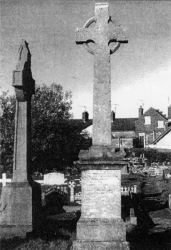
The inscription engraved on the plinth of
this tall cross in the Dougher cemetery reads:- This Cross
marks the site of the Altar of the old Parish Church of
Shankill, and was solemnly blessed and indulgenced at the
end of the Mission given by the Passionist Fathers in June
1877.
1829 - Probably as a response to the passing
of the Catholic Emancipation Act of 1829, Charles Brownlow granted an
appropriate site in North Street, Lurgan, to the Very Reverend William
O'Brien, Parish Priest, for the erection of a parish church.
1832 - Work on the new St. Peter's Church is
well under way. Alex Richmond's Map of Lurgan, 1832, shows two Catholic
Churches close together, one in Dougher, and one in the Back Lane (North
Street).
1833 - Dedication of the new St. Peter's on
September 1st. 1833 by the Most Reverend Dr. Blake, Bishop of Dromore.
1834 - First storey of a parochial house
erected in church grounds, and the Dougher Church converted to parish
schools.

1846-48 - With the Union workhouse located on
the edge of Lurgan town, Father O' Brien undertook the very demanding
duties of workhouse chaplain. With fevers raging in the workhouse and
poverty on the outside, workhouse duties meant that, in effect, the
chaplain was catering for an additional parish. Even on Christmas Day,
Father O'Brien found time to tend to the spiritual welfare of the many
Catholic workhouse inmates.
1860 - Halftown School, now, St. Teresa's was
built. 1862 - Dougher Cemetery enlarged; population of Lurgan town
expanding rapidly after the trauma and suffering of the Great Famine are
receding and the number of linen manufactories is increasing on a yearly
basis.
1863 - The first Shankill Parish Mission was
conducted by three priests from the Order of Charity. With the great
increase in the parish population - the linen trade of Lurgan was in
full swing - two additional curates were appointed, Reverend James
McKenna and Reverend John McConville.
1864 - Parochial House was enlarged.
1865 - Edward Street schools were opened.
1866 - The Sisters of Mercy came to Lurgan and
took charge of the Edward Street schools.
1867-69 - St. Peter's Church is greatly
enlarged with the addition of a new Sanctuary and Transepts. The
foundation stone of this major project, planned and undertaken by the
Very Reverend William O'Brien, was laid by Bishop Leahy on June 29th.
1867, and exactly two years later, Bishop Leahy dedicated the new
additions.
1875 - St. Peter's School for Boys was opened
adjacent to the now greatly enlarged St. Peter's Church in North Street,
Lurgan.
1890-92 A new extension to St. Peter's Church
enlarged the nave bringing the seating capacity to 1,200. The imposing
exterior architecture was complemented by a spacious interior of
refinement and ideal proportion.
1897-1901 - The magnificent spire of St.
Peter's Church, planned by a parish priest who had achieved so much in
enlarging St. Peter's, was dedicated by Dr. O'Neill, Bishop of Dromore,
on August 25th. 1901. The Reverend James O'Hare died in 1897 when the
initial work on the spire had begun. The spire was completed during the
pastorate of the Reverend Michael McConville.
1908 - The present St. Michael's Grammar
School was opened as a Boys' Industrial School.
1915 - The imposing organ which has enriched
so many church services was purchased at �1,000 approximately.
1922-24 - Coinciding with the Golden Jubilee
of the Right Reverend Dean Michael McConville, a new marble High Altar
was installed, the Sanctuary was embellished by a very beautiful array
of mosaics, and a marble Communion Rail erected in memory of the
Catholic dead of Lurgan and District who lost their lives during the
Great War of 1914-18.
1925-27 - The Sacristy was completely
refurbished with pitch-pine compartments. A new Sacred Heart Altar was
installed. The church interior was completely re-decorated to
architectural instructions. The Tower and Spire were `pointed'. The
Tympanum over the main entrance depicting Christ handing the keys to
Saint Peter was carved, and the Papal Crest in stone carved over the
door of the Tower.

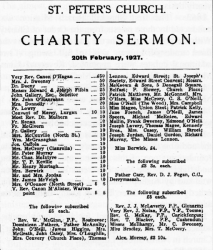
Page One of
the booklet containing the names of contributors and the
amounts contributed to the Charity Sermon preached on
February 20th. 1927 to raise the money required to
remove all debt accrued in the final phase of building
the magnificent church. The debt having been wiped out,
St. Peter's was solemnly consecrated three months later,
on May 18th. 1927.
1927 - St. Peter's Church, being free from
debt on account of extraordinary generosity of parishioners, many of
whom were of deep faith and modest means, was consecrated on Thursday
19th. May 1927 by Most Reverend Dr. Edward Mulhern, Bishop of Dromore,
with the Solemn Celebrations of the Consecration taking place on Sunday
22nd. May 1927, presided over by His Eminence Cardinal O'Donnell,
Archbishop of Armagh.
1933 - The Centenary of the erection and
dedication of St. Peter's Church was celebrated on Sunday 3rd. September
1933 by a Solemn High Mass in the presence of Cardinal MacRory, Bishop
Mulhern and a large gathering of Priests. The celebrant of the Mass was
Reverend J. P. Burke; Deacon, Reverend A.J. Sweeney; Sub-Deacon,
Reverend J.E. Murtagh; Master of Ceremonies, Reverend David Gallery. All
four priests had affiliation with Shankill Parish and Lurgan from
childhood.
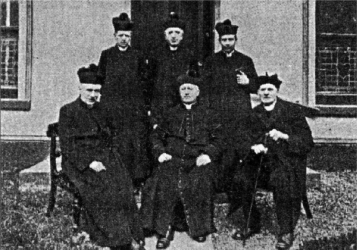
Priests of
Lurgan, 1927:- (left to right, sitting): Rev. H.
McGivern, C.C.; Very Rev. D. Canon O'Hagan, P.P., V.G.;
Rev. A. Lowry, C.C. Standing: Rev. S. McNulty, C.C.;
Rev. W. Ronan, C.C.; Rev. D. Gallery, C.C.
1937 - St. Colman's Cemetery came into being
on account of the diminishing capacity of the Dougher Cemetery to
accommodate additional burials. Two major extensions of the cemetery
have been carried out.
1958-59 - The Side-Altars, dedicated to The
Sacred Heart and to Our Lady were embellished by appropriate mosaic
designs.
1968 - Entire flooring within the church was
replaced, the organ was remodelled, and the great spire and cross were
examined and repaired.

1982 - On Sunday 26th. December 1982, Bishop
Francis Gerard Brooks consecrated the Altar of St. Peter's Church
following the re-construction of the Sanctuary. A permanent marble altar
now faces the congregation. An ambo fashioned from the marble of the
original pulpit, and a marble chair made from the marble of the original
altar, have been incorporated into the Sanctuary. The Reredos remains
intact and the floor of the Sanctuary has been raised. The Baptismal
Font now rests beside the Communion passage at the front of the
Sanctuary.
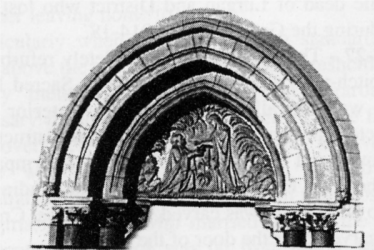
Above the
main entrance to St. Peter's Church is a splendid stone
carving depicting Christ entrusting the keys of the
Kingdom of Heaven to Saint Peter.
1983 - On October 2nd. 1983, special
ceremonies were held to commemorate the 150th. Anniversary of the
Dedication of St. Peter's Church. Bishop Francis Gerard Brooks was the
principal celebrant of a Mass of Thanksgiving. Twenty-six priests
concelebrated, all of whom had strong affiliation with the church,
either as parish priests, curates or natives of the parish.
1992 - Sunday, 14th. June: A concelebrated
Mass of Thanksgiving was held in St. Peter's Church, Lurgan on the
occasion of the 50th. anniversary of the ordination of the Right Rev.
Monsignor Christopher Murray, P.P� V.G., Lurgan, Very Rev. Canon Patrick
Smyth, P.P., Ballynahinch and Very Rev. James Fitzpatrick. P,P.,
Annaclone. The other concelebrants were Rev. Michael Hackett, C.C.,
Lurgan who was celebrating his Silver Jubilee in the priesthood, Rev.
Michael Maginn, C.C., Newry, a native of Lurgan, was the preacher.
Bishop Brooks presided and a great number of Dromore priests and some
from the Dioceses of Armagh, and Down and Connor were present along with
a full church for the joyful occasion.
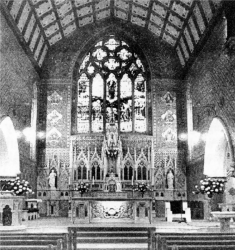
The large and
beautiful Sanctuary of St. Peter's Church, Lurgan. The great
Ascension window is flanked by coloured and golden
portraiture of the Irish Saints.
1992 - Friday, 4th. September The parish of Shankill was divided
into two parishes. St. Peter's and St. Paul's, Shankill. The new parish
of St. Peter's consists of the following townlands - Kinnego, Clanrolla,
Liscorran, Tullydagan. Tannaghmore North, Lurgantarry, Cornakinnegar,
Drumnanoe, Tullyronnelly, Kilmore, Killaghy, and part of each of Lurgan,
Drumnakelly, Ballyblagh, Dougher. Knocknashane, Derry and Turmoyra.
The new parish of St. ,Paul's consists of the
following townlands - Annaloiste, Boconnell, Knockramer, Silverwood,
Shankill, Taghnevan, Tannaghmore South, Tobernewey, Aughnacloy, Tirsogue,
and part of Lurgan. Drumnakelly, Ballyblagh, Dougher, Knocknashane,
Derry, Turmoyra, and part of Ballinamoney, (the other part in Seagoe
parish), and part of Monbrief, (the other part in Moyraverty parish).
Friday, 11th. September Bishop Brooks made the
following clerical changes - Very Rev. Arthur Byrne. P.P., Kilbroney to
be P.P. of St. Peter's, Lurgan, and V.G. of the diocese.
Rev. Francis Molloy, C.C., Craigavon to be P.P., St.
Paul's, Lurgan.

In 1411, The Reverend Patrick McGwyryan (McGivern)
was described as 'Rector Ecclesiae Parochialis De Kyl-Milcon', or Rector
of the Parish Church of Kilwilke.
In 1788, the Reverend John O'Kelly was
appointed Administrator of Shankill and, in 1815, he was appointed
Parish Priest. Shankill Parish had become an important and distinctive
entity in its own right.
Father O'Kelly, whose brother was Bishop of Dromore,
died on February 28th. 1825, and was interred in Laurencetown Cemetery
where his brother was buried six months later.
To Shankill Parish, Lurgan, came the Reverend
William O'Brien from the Broadwater area, near Aghalee. Dr.
O'Brien's pastorate in Lurgan, from 1822 to 1825, as a Curate. and
1825-1870, as Parish Priest, was filled with arduous pastoral and
spiritual achievements, with building projects of church and schools,
with tending daily to the many poor of the parish, and with raising the
morale and moral standards of a people attempting to recover from the
debilitating effects of the Penal Laws and the Great Famine. This great
man who generated the development of Shankill Parish and the erection of
St. Peter's Church, died on May 31st. 1870, aged 74 years, and was
interred underneath the Sanctuary in St. Peter's Church.
The quotations which follow characterise his
pastorate, and are taken from the Chaplains' Book of Lurgan Union
workhouse, and relate to the Christmas period of 1846, when the deadly
grip of the Famine had taken hold, a period known locally as `the dear
Winter'. Chaplains were required to specify their pastoral activities in
the workhouse, and to sign all entries in the book. The following three
entries were signed simply, W.O'Brien:
December 25th. Baptised William, of Win.
McLoughlin and Ann Keenan. Sponsors, Charles McCann and Margaret Hernnon.
Attended three sick calls in the Female Infirm Ward, Catechised the
children, and read Evening Prayer in the school room.
December 26th. Blessed a grave for the
interment of two little children. Read the Funeral Service over the
remains of two aged persons. Attended three sick calls in the Male
Infirm Ward, three sick calls in the Male Infirmary, and four sick calls
in the Female Idiot Ward.
December 27th. Divine Service and Instruction.
Visited two sick men' in the Infirmary, and two sick persons in the
Fever Hospital. Catechised the children and read Evening Prayers in the
school room.
The Reverend James McKenna who had come to Lurgan in
1867, aged 38 years, to assist Dr. O'Brien, was appointed Parish Priest
in June 1870. He enlarged St. Peter's Church to meet the needs of a
rapidly expanding population and undertook a lecture tour in the U.S.A.
to raise funds for the parish. Father McKenna, a Newry-born priest, died
in Lurgan on October 20th. 1885, aged 56 years, and was interred within
the Sanctuary of St. Peter's Church.


Large white
marble tablet inscribed in Latin with gold lettering
recounting the history of St. Peter's Church, Lurgan. The
inscription celebrates the Solemn Consecration of the church
on May 18th. 1927. The cathedral-like edifice is among the
finest parish churches in Ireland and manifests the great
progress made by the Irish Church during the one hundred
years which followed the Catholic Emancipation Act of 1829.
The first line of the inscription reads:-
Fideles
hujus Pardeciae Missam sus diva per breve tempus
in moledino desueto in loco Dougher
referring to the
faithful attending Mass for a short period in a disused
building in the Dougher.
The subsequent parish priest, the Reverend Arthur James Finnegan,
was a former President of St. Colman's College, Newry, and his
appointment in Lurgan began on November 2nd. 1885. His work for the
parishioners of Shankill Parish was cut short by illness and he passed
away on July 1st. 1889, aged 66 years, after only four years as parish
priest.
The Reverend James O'Hare was appointed Parish Priest of
Shankill on July 13th. 1889. In the period of enormous change, 1868-78,
Father O'Hare was a curate in St. Peter's Church, and this experience
and knowledge of town and people was of great benefit during his eight
years as parish priest. He undertook many educational initiatives much
needed in the parish and organised the enlargement of St. Peter's Church
to its most impressive size and capacity. Just before his untimely death
on August 16th. 1897, aged 59 years, he began the detailed planning for
the imposing spire which makes St. Peter's Church the landmark which it
is for people from far and near.
Reverend Michael Blake McConville, 1897 to 1925; Father
McConville had spent 19 years as a curate in Lurgan. Thus, on his death
on February 24th. 1925, aged 77 years, he had ministered to parishioners
for almost 47 years.
One outstanding parish priest was followed by another as the Very
Reverend Daniel O'Hagan, President of St. Colman's College, Newry, was
appointed to Shankill on March 20th. 1925. While Dean O'Hagan's
pastorate could be specified in terms of building projects of church and
schools and by great occasions, it was his impact on the Faith and
morale of parishioners which is and will be long
remembered. In a parish recovering from the grim social effects of
World War I and enduring the terrible upheavals of World War II, Dean
O'Hagan maintained a daily ministry in church, in streets, in schools
and in homes. Put simply, he was a devout priest who wanted the best in
Faith for each and every parishioner. Dean O'Hagan passed away on
November 10th. 1954, aged 78 years.
Reverend Edward Campbell, Administrator of Newry Parish, was
appointed Parish Priest of Shankill in March 1955. During his nine years
in Lurgan, Monsignor Campbell planned and guided the erection of two
major new schools, St. Mary's (1958-59) and St. Paul's (1962) and took a
great initiative in the planning and building of the new St. Paul's
Church to cater for the growing population of Lurgan who were in the
process of major re-housing and re-location. This was the period of new
housing developments and urban expansions. Complications encountered in
the building of St. Paul's Church, and the need to generate funds to
reduce a substantial parish debt became heavy burdens for Monsignor
Campbell to carry. He died on January 9th. 1964 and left the parish
geared to meet the educational needs of a new and very demanding era. He
was interred in St. Colman's Cemetery.

To the next Parish Priest, Monsignor James Haughey, was
appointed in April 1964, fell the task of having St. Paul's Church, in
Francis Street, completed. St. Paul's Church, in which Mass was first
celebrated on Christmas Eve, 1965, was officially opened and dedicated
on Low Sunday, 1966, amid much pageantry and celebration. Monsignor
Haughey, a past-President of St. Colman's College, Newry, organised the
planning and building of two new schools in Francis Street, and, as
Monsignor Campbell had also done, carried out repairs and refurbishment
of St. Peter's Church. Monsignor Haughey retired from Shankill Parish in
December 1979, and died in Rostrevor on March 16th. 1995.
Monsignor Christopher Murray was appointed Parish Priest of
Shankill on January 1st. 1980. Blessed with the attributes of
scholarship, humility, fidelity and Faith. Monsignor Murray came to
Lurgan, the centre of a large and settled parish from the new and
developing Parish of Moyraverty where he had faced many difficulties in
the spheres of population mobility, social deprivation and economic
shortcomings. The new parish priest shone in all aspects of pastoral and
spiritual endeavour, and he became a leader of all the people in prayer
and Christian outlook. Monsignor Murray celebrated his Golden Jubilee in
the Priesthood on Sunday 14th. June 1992 with a concelebrated Mass of
Thanksgiving in St. Peter's Church. He was joined in the celebrations by
two additional Golden Jubilarians, Very Reverend James Fitzpatrick, P.P.
Annaclone, and
Canon Patrick Smyth, P.P. Magheradroll, a highly
esteemed former curate of Shankill Parish. At the division of Shankill
Parish into two parishes on Friday 11 th.September 1992, Monsignor
Murray retired as parish priest, and went to dwell in nearby Tullylish
Parish where he actively contributed to the spiritual life of the
parish. He died on December 2nd. 1999, and was interred in Laurencetown
cemetery.

The beautiful
Pieta located in the former baptistry in St. Peter's Church
was commissioned by Monsignor Christopher Murray following
the reconstruction of the Sanctuary in December 1982. In the
reconstruction, the reredos remained intact and the floor of
the Sanctuary was raised to the level of the predella. The
baptismal font was relocated from the rear of the church to
the Communion passage at the front of the Sanctuary.
Monsignor Arthur Byrne, a native of the
parish, was appointed Parish Priest in September 1992. A classical
scholar, Monsignor Byrne had served as Administrator of Newry Parish
with distinction and came to Lurgan with an abundance of pastoral and
administrative experience. His ten years in St. Peter's, Shankill, were
marked by the modernising of parish structures, full support for all
Church-related organisations in the parish, the necessary expansion of
an already large St. Colman's Cemetery, and leadership in a variety of
devotional practices which once again became an integral part of parish
life. A splendid new parochial house was erected for the parish curates,
the old St. Peter's School was tastefully refurbished, and a major
programme of exterior maintenance was begun on the cathedral-like St.
Peter's Church. Six months after celebrating his Golden Jubilee in the
Priesthood, Monsignor Byrne resigned his appointment on December 31st.
2002.

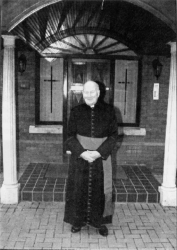
Monsignor
Arthur Byrne, retired Parish Priest of St. Peter's,
Shankill, outside the porch of the splendid new
Parochial House, North Street, Lurgan.
Father Kieran McPartlan was appointed
Administrator of St. Peter's Parish from January to July 2003, at which
time Canon Aidan Hamill was appointed Parish Priest. Canon Hamill
was ordained in St. Patrick's Church, Magheralin, his native parish, on
Sunday 8th. June 1969. He served in St.Colman's College and in various
parishes including significant years as C.C. Magheradroll. In August
1994, he was appointed Parish Priest of Drumgath where he remained until
July 1998 when he was appointed as Administrator of Newry Parish and
made a Canon of the Chapter. On July 21st. 2003, Canon Hamill's
appointment to Shankill, St. Peter's was announced, and on January 16th.
2004, he was honoured by the conferring of the title, Monsignor. Also in
January, a major new phase of renewal and refurbishment of church
property in North Street, Lurgan, was begun. St. Peter's, Shankill,
being the older of the two parish divisions, has a considerable number
of parish-associated voluntary organisations. These provide the parish
and its people with a marked degree of cohesion, and add greatly to its
identity as a caring parish. The members of these groupings are people
whose Faith is expressed in worship and good deeds. Some of these
organisations were established by curates in times past. Reverend
Stephen McNulty, who served in Lurgan for 28 years, 1923-51,
Reverend Patrick Smyth, 27 years, 1948-75, and
Reverend James McEvoy, 16 years, 1948-64, represent the great body of
priests who served Shankill Parish so faithfully and so well before
moving on to serve elsewhere in the Dromore Diocese as parish priests.
Alongside the priests, the dedicated nuns of the
Sisters of Mercy worked tirelessly for parishioners since arriving in
Lurgan in 1866. Their work in the spheres of education, in alleviating
the distress of local disadvantaged families, and in visitation of the
sick and deprived, shaped the parish in a way no other body could have
done.
Today, priests, Mercy Sisters and people, together
with the many lay groupings and schools, combine to serve the Almighty
in a large modernising parish located on the southern shore of Lough
Neagh, close to that point where the three counties of Armagh, Down and
Antrim meet.
GOLDEN JUBILEE CELEBRATIONS -
PAROCHIAL HOUSE, LURGAN - SUNDAY 14th. JUNE 1992
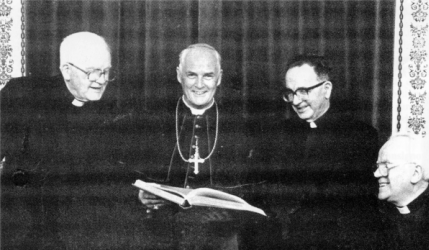
Very
Reverend James Fitzpatrick, P.P. Annaclone; His Lordship
Bishop F.G. Brooks; Very Reverend Canon Patrick Smyth,
P.P. Magheradroll; Right Reverend Monsignor Christopher
Murray, P.P. V.G. Shankill.
The three parish priests jointly celebrated the Golden
Jubilee of their Ordination to the Priesthood in a
special Concelebrated Mass in St. Peter's Church,
Lurgan, with 64 priests concelebrating.
 |